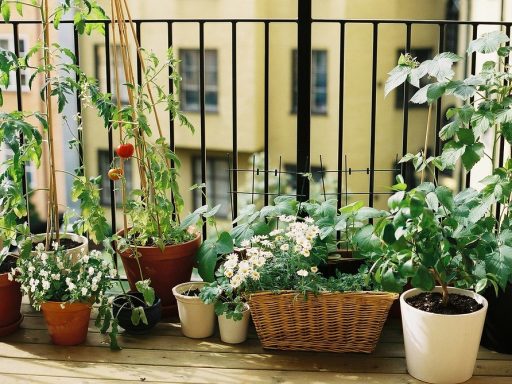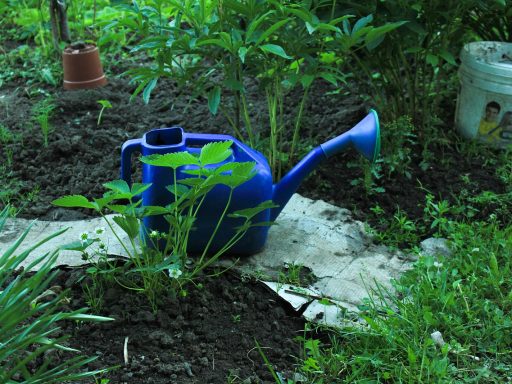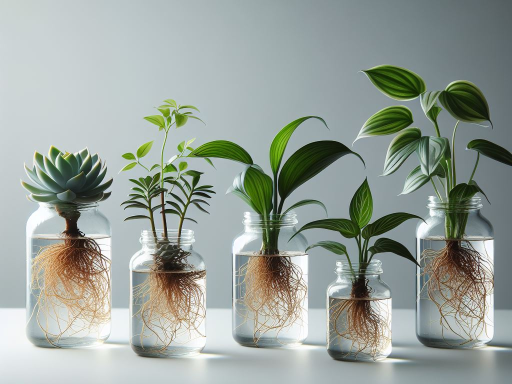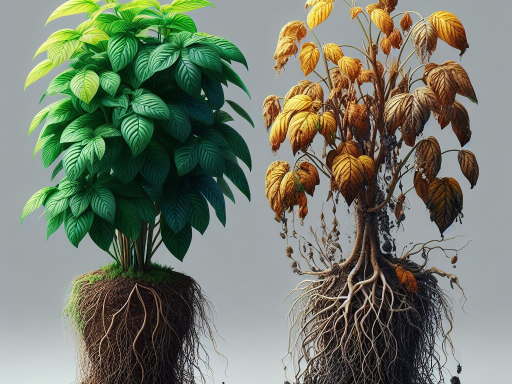Are you a culinary enthusiast, a health-conscious individual, or simply someone who loves the aroma of fresh herbs? Growing your own herbs at home is a rewarding experience that not only adds flavor to your meals but also provides a sense of accomplishment and connection with nature. In this comprehensive guide, Daphne’s Corner will take you on a journey through the art of cultivating herbs, sharing valuable tips, tricks, and insights to help you create a thriving herb garden right in your backyard or on your windowsill.

Why Grow Herbs at Home?
Growing herbs at home offers numerous benefits that extend beyond just adding flavor to your dishes. Here are a few compelling reasons to consider starting your own herb garden:
- Fresh and Flavorful: Freshly harvested herbs have an unparalleled aroma and flavor that elevates any dish. Say goodbye to bland and lifeless herbs from the grocery store.
- Cost-Effective: Growing your own herbs can save you a significant amount of money in the long run. Instead of constantly buying fresh herbs from the market, you’ll have a renewable source right at your fingertips.
- Health Benefits: Many herbs are packed with essential nutrients, antioxidants, and compounds that promote overall well-being. By growing your own, you can ensure the herbs are free from harmful pesticides and chemicals.
- Convenience: Having a personal herb garden means you’ll always have fresh herbs on hand, eliminating the need for last-minute trips to the store.
- Environmental-Friendly: By growing your own herbs, you’re reducing your carbon footprint and supporting sustainable living practices.
Choosing the Right Herbs
Before you dive into the world of herb gardening, it’s essential to choose the right herbs to grow. Consider the following factors:
- Climate and Growing Conditions: Some herbs thrive in warm climates, while others prefer cooler temperatures. Research the ideal growing conditions for the herbs you want to cultivate.
- Space Availability: Determine whether you’ll be growing your herbs indoors or outdoors, and choose herbs that suit the available space.
- Personal Preferences: Select herbs that you enjoy using in your cooking or those with medicinal properties that interest you.
Here’s a comparison table to help you choose the best herbs for your needs:
| Herb | Sun Exposure | Water Needs | Climate Preference | Ideal For |
|---|---|---|---|---|
| Basil | Full sun | Moderate | Warm | Tomato dishes, pesto, salads |
| Rosemary | Full sun | Low | Warm | Roasted meats, breads, stews |
| Thyme | Full sun | Low | Cool to warm | Soups, stews, marinades |
| Mint | Partial shade | Moderate | Cool to warm | Teas, cocktails, desserts |
| Cilantro/Coriander | Full sun | Moderate | Cool | Mexican and Asian cuisines |
| Chives | Full sun | Moderate | Cool to warm | Soups, salads, baked potatoes |
| Parsley | Partial shade | Moderate | Cool | Garnishes, sauces, salads |
This table provides a general overview, but it’s essential to research the specific needs of each herb you plan to grow to ensure their success.
Setting Up Your Herb Garden
Once you’ve chosen the herbs you want to cultivate, it’s time to set up your herb garden. Here are some tips to help you get started:
Choosing the Right Location
- Outdoor Gardens: Select a spot that receives ample sunlight (at least 6 hours per day) and has well-draining soil. Consider raised beds or containers if your soil quality is poor.
- Indoor Gardens: Windowsills, balconies, or a dedicated grow room with grow lights can be excellent options for indoor herb gardens.
Preparing the Soil
Herbs thrive in nutrient-rich, well-draining soil. If you’re using containers, choose a high-quality potting mix specifically designed for herbs or vegetables. For outdoor gardens, amend the soil with compost or well-rotted manure to improve its quality.
Planting and Spacing
Follow the recommended spacing guidelines for each herb variety to ensure proper growth and air circulation. Some herbs, like mint, are aggressive spreaders and should be planted in separate containers to prevent them from overtaking the garden.
Watering and Feeding
Herbs have different water and nutrient requirements. As a general rule, water them when the soil is partially dry, and avoid overwatering, which can lead to root rot. Incorporate a balanced, slow-release fertilizer or compost tea every few weeks to provide nutrients.
Pruning and Harvesting
Regular pruning and harvesting encourage bushier growth and higher yields. Snip off the top leaves or stems, leaving enough foliage for the plant to continue growing. Harvest in the morning when the essential oils are most concentrated for maximum flavor.
Companion Planting for a Thriving Herb Garden
One of the secrets to a successful herb garden is practicing companion planting. This ancient technique involves strategically planting certain plants together to benefit from their natural abilities to repel pests, attract beneficial insects, or enhance growth and flavor. By understanding the principles of companion planting, you can create a harmonious and productive herb garden.
Pest Deterrents
Some herbs have natural pest-repelling properties that can help protect other plants in your garden. For example:
- Planting basil near tomatoes can deter tomato hornworms and aphids.
- Interplanting chives with carrots and roses can ward off carrot flies and aphids, respectively.
- Growing rosemary and sage near plants prone to cabbage worms can discourage these pests.
Beneficial Insect Attractors
Certain herbs can attract beneficial insects, such as ladybugs, lacewings, and parasitic wasps, which prey on garden pests. Consider planting:
- Dill and fennel to attract lacewings and ladybugs, which feed on aphids and mites.
- Coriander and parsley to attract syrphid flies, whose larvae consume aphids and other soft-bodied insects.
- Yarrow and chamomile to lure in beneficial wasps that parasitize caterpillars and other pests.
Growth Enhancers
Some herbs have the ability to improve the growth and flavor of their neighboring plants:
- Plant basil near tomatoes to enhance their growth and flavor.
- Interplant chives with carrots to improve their flavor and repel carrot flies.
- Grow chamomile near brassicas (e.g., broccoli, cauliflower, cabbage) to improve their flavor and promote overall plant health.
Designing Your Companion Planting Layout
When planning your companion planting layout, consider the following tips:
- Grouping: Group plants that benefit each other in close proximity. For example, plant tomatoes, basil, and marigolds together for a mutually beneficial trio.
- Spacing: Ensure adequate spacing between plants to prevent overcrowding and competition for resources.
- Aesthetics: Arrange plants in an visually appealing manner, considering color, texture, and height variations.
- Crop Rotation: Practice crop rotation to prevent soil depletion and pest buildup in any one area.
- Diversity: Incorporate a diverse range of herbs and companion plants to create a balanced ecosystem in your garden.
Harvesting and Preserving Your Herb Bounty
As your herb garden flourishes, you’ll likely have an abundance of fresh herbs to enjoy. Here are some tips for harvesting and preserving your herb bounty:
Harvesting Tips
- Harvest herbs in the morning after the dew has evaporated for maximum flavor and aroma.
- Use clean, sharp scissors or pruners to snip off the stems, leaving enough foliage for the plant to continue growing.
- For herbs like basil, pinch off the top sets of leaves to encourage bushier growth.
- Avoid harvesting more than one-third of the plant at a time to prevent over-stressing it.
Preservation Methods
- Drying: Air-drying or using a dehydrator is an excellent way to preserve herbs for long-term storage. Dried herbs retain their flavor and can be used in cooking, teas, and potpourri.
- Freezing: Chop fresh herbs and freeze them in ice cube trays with water or olive oil for easy portioning and use in cooked dishes.
- Infusing Oils or Vinegar: Create flavorful herb-infused oils or vinegar by submerging fresh herbs in your chosen oil or vinegar for several weeks.
- Pesto or Herb Butters: Blend fresh herbs with olive oil, garlic, and nuts to make pesto or herb-infused butters that can be frozen for later use.
By embracing companion planting techniques and properly harvesting and preserving your herb bounty, you’ll not only enjoy a thriving and productive herb garden but also have a constant supply of fresh and flavorful herbs at your fingertips.
Herb-Inspired Recipes and Ideas
With a bountiful herb garden, the culinary possibilities are endless. Here are some delicious and creative ways to incorporate your homegrown herbs into your meals and beyond:
Herbal Infusions and Beverages
- Herbal Teas: Steep fresh or dried herbs like mint, chamomile, lemon balm, or lavender for a refreshing and soothing cup of herbal tea.
- Herb-Infused Lemonades and Cocktails: Add a burst of flavor to lemonades, cocktails, or mocktails by muddling fresh herbs like basil, rosemary, or thyme.
- Herbal Syrups: Create versatile herbal syrups by simmering herbs like lavender, mint, or rosemary with sugar and water. Use them to sweeten drinks, drizzle over desserts, or add to marinades.
Savory Dishes and Condiments
- Herb-Crusted Meats and Fish: Create flavorful crusts by coating proteins with a mixture of breadcrumbs, fresh herbs (such as parsley, thyme, or rosemary), and spices.
- Herb-Infused Oils and Vinegar: Drizzle herb-infused olive oils or vinegar over salads, roasted vegetables, or use them as marinades for added depth of flavor.
- Herb-Packed Pestos and Sauces: Blend fresh herbs like basil, parsley, or cilantro with garlic, nuts, and olive oil to create vibrant pestos or sauces for pasta, meats, or dips.
- Herbal Compound Butters: Mix softened butter with finely chopped fresh herbs like chives, dill, or tarragon. Spread over bread, fish, or use as a flavorful finishing touch for cooked dishes.
Baked Goods and Desserts
- Herb-Infused Breads and Scones: Incorporate fresh or dried herbs like rosemary, thyme, or lavender into bread doughs, scones, or biscuit recipes for a savory twist.
- Herbal Shortbread and Cookies: Enhance the flavor of classic shortbread or sugar cookies with finely chopped fresh herbs like lemon verbena, lavender, or mint.
- Herb-Infused Syrups and Glazes: Create herbal syrups or glazes using herbs like rosemary, thyme, or basil to drizzle over cakes, tarts, or other desserts.
Home and Beauty Uses
- Herbal Bath Salts and Sachets: Combine dried herbs with Epsom salts and essential oils for relaxing bath soaks or create fragrant sachets for drawers or linen closets.
- Herbal Skin Care Products: Infuse homemade soaps, lotions, or facial mists with fresh or dried herbs like lavender, chamomile, or rosemary for their soothing and rejuvenating properties.
- Herbal Potpourri and Room Sprays: Dry a blend of aromatic herbs like lavender, rosemary, and mint to create natural potpourri or mix with water for refreshing room sprays.
With a little creativity and your homegrown herb bounty, you can elevate your culinary creations, beverages, and even personal care products with the vibrant flavors and aromas of fresh herbs. Experiment, explore, and enjoy the versatility of your herb garden!
Frequently Asked Questions (FAQs)
1. Can I grow herbs indoors all year round?
Yes, with the right setup and conditions, you can grow herbs indoors year-round. Choose herbs that are suitable for indoor cultivation, such as basil, chives, parsley, and mint. Provide adequate lighting (either from a sunny window or grow lights), proper soil, and consistent watering.
2. How do I prevent pests and diseases in my herb garden?
Maintaining a healthy garden environment is key to preventing pests and diseases. Practice crop rotation, remove dead or diseased plant material promptly, and consider using organic pest control methods like neem oil or insecticidal soap. Additionally, ensure proper air circulation and avoid overwatering.
3. Can I grow herbs from seed or cuttings?
Yes, you can grow herbs from both seeds and cuttings. Starting from seeds is more economical but requires patience, as it can take several weeks for seedlings to emerge and mature. Cuttings, on the other hand, allow you to propagate established plants more quickly, but you may need to purchase starter plants.
4. How do I preserve fresh herbs for later use?
There are several methods for preserving fresh herbs, including:
- Air-drying: Tie herb bunches together and hang them upside down in a warm, dry area.
- Freezing: Chop fresh herbs and freeze them in ice cube trays with water or olive oil.
- Dehydrating: Use a dehydrator or your oven’s lowest setting to dry herbs for long-term storage.
- Infusing oils or vinegar: Fill jars with fresh herbs and cover with oil or vinegar, creating flavorful infusions.
5. What are some creative ways to use fresh herbs?
Fresh herbs can be used in a variety of creative ways beyond cooking. Try making herb-infused oils, vinegar, butter, or salts. Incorporate them into cocktails, lemonade, or iced teas. Use them in homemade beauty products like face masks, scrubs, or hair rinses. Get creative and explore the endless possibilities!
Additional Resources
To further your knowledge and stay inspired, here are some additional resources for growing herbs at home:
- Gardening Forum – Connect with experienced gardeners and seek advice on herb cultivation.
- Herb Society of America – A non-profit organization dedicated to promoting the knowledge and use of herbs.
- YouTube Channel: Daphne’s Corner – Subscribe to Daphne’s Corner for helpful videos on gardening tips and herb recipes.
- Instagram: @daphnescorner – Follow Daphne’s Corner on Instagram for beautiful herb garden inspiration and updates.
Remember, growing herbs at home is not only a practical endeavor but also a therapeutic and rewarding experience. Embrace the process, experiment with different varieties, and most importantly, enjoy the fresh flavors and aromas that your homegrown herbs bring to your culinary creations.
Happy gardening!




